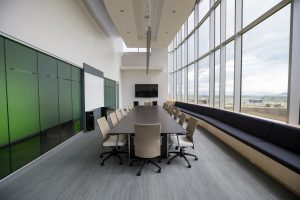The Arapahoe Ridge area will see big changes to the familiar Eastpoint complex at Arapahoe and Eisenhower in the near future. The buildings in the complex are about 43 years old—too outdated to refurbish. Developers plan to completely replace the complex with innovative buildings, underground parking, and more open green space. Construction should be finished by spring 2019.

Buildings
The Eastpoint plan calls for a high density, multi-family residential complex of middle income housing. There will be 5 buildings instead of the current 8. The new 3-story buildings will increase total apartments from 140 to 226. More affordable housing is a benefit to Boulder because it will allow more families to live in Arapahoe Ridge. This is an area of Boulder where job opportunities are expanding.
The innovative, modern buildings all have flat roofs. About three-quarters of the roof surface will be covered with plants. The remaining quarter could be used for solar energy in the future.
Residents will enjoy a fitness center with a climbing wall, an indoor/outdoor pool, yoga room, and lounges. Add to that a dog park, and a network of bike- and pedestrian-friendly multi-use pathways.
Parking Underground Means More Open Space
Once rebuilt, Eastpoint will have about 30 percent more open space. This means about 6 acres on the 7-acre site will be open with no buildings.
Much of the gain in open space is because of the underground parking. All parking is under the buildings, except for 7 visitor spaces, which will greatly reduce the amount of paved areas. The underground garage has a large area for storing bikes. The top of the garage will be planted with a Zen Garden.

Underground parking is certainly more attractive, since it reduces paving and hides cars. However, the downside is that it allows has more parking spaces onsite. That will mean more cars and people on the road at Arapahoe and Eisenhower, especially during peak traffic times.
Modernization and a green plan for the Arapahoe Ridge Eastpoint Apartments will bring more affordable housing to the area. But that also means more people and cars on the move in a sensitive area. The next article talks a bit more about traffic management and transportation choices for this development.





